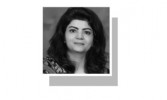PAKISTAN ranks low on the Gender Gap Index in the World Economic Forum’s Global Gender Gap Report, 2023. On women’s political empowerment, it ranked 95th out of 146 countries, with only a handful of women occupying senior, managerial, policy- and decision-making posts. The main factors preventing women from achieving gender parity in politics are a patriarchal system, systemic gender discrimination, socioeconomic disparity, and hidebound cultural norms.
The Constitution is clear that “there shall be no discrimination on the basis of sex alone” and that “steps shall be taken to ensure full participation of women in all spheres of national life”. Besides, Pakistan is a signatory to the UN Convention on the Elimination of All Forms of Discrimination against Women, which obligates governments to “take all appropriate measures to eliminate discrimination against women in political and public life”, including in elections.
Pakistan’s women constitute almost half of the population, but their share in parliament is just 20 per cent. The gender gap also exists among voters.
Women’s participation and representation in the political process is a fundamental principle of democracy, and it is a prerequisite for gender-sensitive and gender-responsive governance. Ensuring the latter is only possible by increasing the number of women in policy- and decision-making positions and providing them with a conducive and women-friendly environment. According to UN Women, “in the last 25 years, women’s political representation has doubled globally. Even then, more than three-quarters of seats in parliament are still held by men”.
We are taking small but significant steps to narrow the gender gap.
Pakistan is making small but significant efforts to narrow the gender gap in the country’s political process. For instance, reforms were introduced in the Elections Act, 2017, to address some of the concerns pertaining to women’s exclusion from the electoral process, and to ensure their active participation, which included mandating that at least five per cent of each political party’s nominated candidates for elections be women; election results be nullified in any constituency where women’s turnout was below 10pc; etc. The Election Commission of Pakistan first released gender-disaggregated turnout statistics in the 2018 election.
According to a voter turnout assessment report by the Free and Fair Election Network (Fafen), which was released soon after the general election last month, “the targeted initiatives have reduced the overall gender gap on the voter rolls between male and female voters from 12.4 million in 2018 to 9.9m in 2024”.
However, women’s turnout remained 43pc as compared to 52pc for males. The major political parties had nominated 280 women candidates, representing 4.64pc of the total 6,037 candidates, while the number of independent women candidates was 614. Twenty-seven women candidates won national and provincial seats in the general elections.
Fafen said: “According to the available data, as many as 24.05 women cast their votes in 254 NA constituencies as compared to 34.02 men in the same constituencies” and that “as many as 2.3m more women turned out to vote in 2024 as compared to 2018, when 21.7m women had cast their votes”. It revised an earlier estimate that the turnout of women in NA-42 was less than 10pc to assert that that turnout in this South Waziristan constituency was, in fact, around 16pc. At the other positive extreme, NA-214 in Sindh reported a women turnout of over 70pc.
However, Fafen observed that the gender analysis of voter turnout needed to be further tweaked, as the Form 47 from 20 constituencies did not include the gender disaggregation of votes polled.
All political parties must comply with Section 206 of Election Act, 2017, which requires an allocation of 5pc quota for women in the general elections.
When it comes to the manifesto of the major political parties, there are promises regarding women’s empowerment. Some parties have focused more on economic empowerment and income generation than legislative reforms. In contrast, the PPP specifically focused on legislative reforms, which includes raising the number of reserved seats for women from 17pc to 33pc in the national and provincial assemblies, increased female representation in parliamentary committees, and raising electoral tickets for women candidates on general seats from 5pc to at least 15pc.
There is growing awareness and desire among women for active engagement in the political process to ensure they are represented in policy- and decision-making circles. Greater participation by them will certainly lead to more inclusive and equitable gender representation in the political sphere in the years ahead.
The writer is a lawyer.
Published in Dawn, March 14th, 2024
Gender parity
 226
226
 56
14.03.2024
56
14.03.2024
PAKISTAN ranks low on the Gender Gap Index in the World Economic Forum’s Global Gender Gap Report, 2023. On women’s political empowerment, it ranked 95th out of 146 countries, with only a handful of women occupying senior, managerial, policy- and decision-making posts. The main factors preventing women from achieving gender parity in politics are a patriarchal system, systemic gender discrimination, socioeconomic disparity, and hidebound cultural norms.
The Constitution is clear that “there shall be no discrimination on the basis of sex alone” and that “steps shall be taken to ensure full participation of women in all spheres of national life”. Besides, Pakistan is a signatory to the UN Convention on the Elimination of All Forms of Discrimination against Women, which obligates governments to “take all appropriate measures to eliminate discrimination against women in political and public life”, including in elections.
Pakistan’s women constitute almost half of the population, but their share in parliament is just 20 per cent. The gender gap also exists among voters.
Women’s participation and representation in the political process is a fundamental principle of democracy, and it is a........
© Dawn
 visit website
visit website






















 Toi Staff
Toi Staff Gideon Levy
Gideon Levy Belen Fernandez
Belen Fernandez Mort Laitner
Mort Laitner Rami G Khouri
Rami G Khouri Ali Fathollah-Nejad
Ali Fathollah-Nejad Nikkei Editorial
Nikkei Editorial
